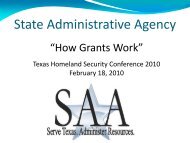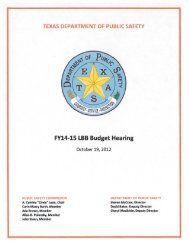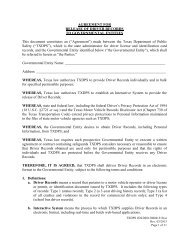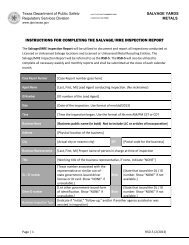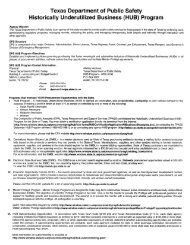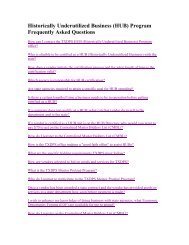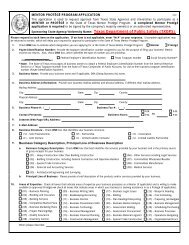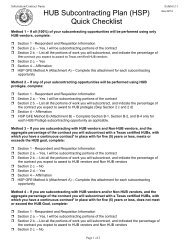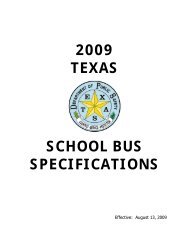Information Security Awareness Training for Texas
Information Security Awareness Training for Texas
Information Security Awareness Training for Texas
You also want an ePaper? Increase the reach of your titles
YUMPU automatically turns print PDFs into web optimized ePapers that Google loves.
CJIS<br />
<strong>In<strong>for</strong>mation</strong> <strong>Security</strong> <strong>Awareness</strong><br />
<strong>Training</strong> <strong>for</strong> <strong>Texas</strong>
Objectives<br />
• This <strong>In<strong>for</strong>mation</strong> <strong>Security</strong> <strong>Awareness</strong> <strong>Training</strong> is<br />
designed to equip those who access the data that moves<br />
through TLETS with basic tools needed to protect<br />
computers and networks interconnecting with Criminal<br />
Justice <strong>In<strong>for</strong>mation</strong> Services (CJIS).<br />
• To ensure compliancy <strong>for</strong> each agency, security<br />
awareness training is required within six months of<br />
employment and every two years thereafter <strong>for</strong> all<br />
employees who access CJIS data. This requirement<br />
applies to IT personnel as well as vendors who work with<br />
networking equipment and/or software which stores<br />
and/or transmits CJIS data.<br />
• The first step to achieving security is awareness.
Overview<br />
In the following <strong>Security</strong> <strong>Awareness</strong> <strong>Training</strong> Document, the following ideas will be discussed.<br />
Terms and Definitions<br />
<strong>In<strong>for</strong>mation</strong> Systems<br />
<strong>In<strong>for</strong>mation</strong> Technology <strong>Security</strong><br />
Goals<br />
Viruses and Reports, Spam<br />
Robust Passwords<br />
Password <strong>Security</strong><br />
Physical <strong>Security</strong><br />
Personnel <strong>Security</strong><br />
Sensitive Data<br />
Storing<br />
Securing<br />
Vulnerabilities and Threats<br />
Social Engineering<br />
Reporting <strong>Security</strong> Violations<br />
Dissemination<br />
Standards of Discipline<br />
Disposal<br />
Summary<br />
CJIS <strong>Security</strong> Office Contacts
List of terms<br />
• Access<br />
• Authorized<br />
Personnel<br />
• CCH<br />
• CJI<br />
• CJIS<br />
• CHRI<br />
• Ill<br />
• LASO<br />
• NCIC<br />
• NLETS<br />
• Phishing<br />
• PII<br />
• TCIC<br />
• TLETS
Terms and Definitions<br />
Access – defined as “the opportunity to make use<br />
of an automated in<strong>for</strong>mation system resource.<br />
Includes the ability to have contact with a<br />
computer from which a transaction may be<br />
initiated.”<br />
Authorized Personnel – defined as “those<br />
persons who have passed a state and national<br />
finger print based background record check and<br />
have been granted access.” These individuals<br />
take security awareness training upon hire and<br />
every two years thereafter to keep current.
Terms and Definitions<br />
CCH - The Computerized Criminal History System is<br />
<strong>Texas</strong>’ central repository <strong>for</strong> arrest, conviction, and<br />
disposition data on individuals arrested <strong>for</strong> felony and<br />
gross misdemeanor offenses. It is used by criminal<br />
justice agencies <strong>for</strong> a variety of reasons, including<br />
decisions regarding investigations, arrests, criminal<br />
charges, plea bargains, convictions, probation, and<br />
placement in correctional facilities. It is frequently used<br />
during mandated background checks on individuals<br />
seeking employment or licensing <strong>for</strong> various employed<br />
and volunteer positions.
Terms and Definitions<br />
CJI – Criminal Justice <strong>In<strong>for</strong>mation</strong> refers to data<br />
provided by FBI CJIS necessary <strong>for</strong> law<br />
en<strong>for</strong>cement and civil agencies to per<strong>for</strong>m their<br />
mission. Examples of CJI data sets housed by<br />
the FBI include:<br />
1. Biometric Data – used to identify individuals; may<br />
include: palm prints, DNA, iris, facial recognition data<br />
as well as fingerprints.<br />
2. Identity History Data – text data that corresponds with<br />
an individual’s biometric data, providing a history of<br />
criminal and/or civil events <strong>for</strong> the identified individual.
Terms and Definitions –<br />
CJI (continued)<br />
3. Person Data – in<strong>for</strong>mation about individuals<br />
associated with a unique case, and not<br />
necessarily connected to Identity History Data.<br />
Person Data does not provide a history of an<br />
individual, only in<strong>for</strong>mation related to a unique<br />
case.<br />
4. Property Data – in<strong>for</strong>mation about vehicles and<br />
property associated with crime.<br />
5. Case/Incident History – in<strong>for</strong>mation about the<br />
history of criminal incidents.
Terms and Definitions<br />
• CJIS - Criminal Justice <strong>In<strong>for</strong>mation</strong> Services is home<br />
to a range of state-of-the-art technologies and statistical<br />
services that serve the FBI and the entire criminal justice<br />
community. CJIS systems include, but are not limited to:<br />
• National Crime <strong>In<strong>for</strong>mation</strong> Center (NCIC)<br />
• Uni<strong>for</strong>m Crime Reporting (UCR)<br />
• Automated Fingerprint Systems (AFIS)<br />
• National Instant Criminal Background Check System<br />
(NICS)<br />
• Interstate Identification Index (III)<br />
• Law En<strong>for</strong>cement Online (LEO)<br />
• National Data Exchange (NDEx)<br />
• National Incident-Based Reporting System (NIBRS)
Terms and Definitions<br />
CHRI - Criminal History Record <strong>In<strong>for</strong>mation</strong> is a subset of CJI that<br />
consists of notations and/or written and/or electronic evidence of an<br />
arrest, detention, complaint, indictment, in<strong>for</strong>mation or other <strong>for</strong>mal<br />
criminal charge relating to an identifiable person. CHRI includes<br />
identifying in<strong>for</strong>mation pertaining to the individual as well as the<br />
disposition arising from sentencing, correctional supervision, and<br />
release of any charges. CHRI is collected by criminal justice<br />
agencies and provided to the <strong>Texas</strong> Department of Public Safety,<br />
Crime Records Service (DPS CRS). DPS CRS is responsible <strong>for</strong><br />
compiling, maintaining and disseminating complete and accurate<br />
criminal history records, criminal incident reports, arrest reports and<br />
statistics. CHRI is not only accessed by criminal justice agencies,<br />
but is also available to non-criminal justice entities. Background<br />
check requests are obtainable in two <strong>for</strong>ms: 1) A personal identifier<br />
or name-based search which obtains in<strong>for</strong>mation based on name<br />
and a numeric identifier and 2) Fingerprints.
Terms and Definitions<br />
III ("Triple-I" <strong>for</strong> short) - is the Interstate Identification<br />
Index. The CJIS service that manages automated<br />
submission and requests <strong>for</strong> CHRI that is warehoused<br />
subsequent to the submission of fingerprint in<strong>for</strong>mation.<br />
III holds the FBI's compilation of an individual's criminal<br />
identification, arrest, conviction, and incarceration<br />
in<strong>for</strong>mation. III provides the FBI's RAP sheet (Record of<br />
Arrest and Prosecution) and contains in<strong>for</strong>mation<br />
reported by local, state and federal law en<strong>for</strong>cement<br />
agencies across the country. Requests associated to a<br />
record housed in a particular state are directed to the<br />
originating State as needed.
Terms and Definitions<br />
LASO – The Local Agency <strong>Security</strong> Officer is required to be<br />
appointed to guarantee five areas of in<strong>for</strong>mation <strong>for</strong> audit<br />
purposes:<br />
1. Identify who is using the approved hardware, software and<br />
firmware and ensure no unauthorized individuals or processes<br />
have access to the same<br />
2. Identify and document how the equipment is connected to the<br />
state system<br />
3. Ensure personnel security screening procedures are being<br />
followed<br />
4. Ensure the approved and appropriate security measures are in<br />
place and working<br />
5. Support Policy compliance and keep state and federal ISO<br />
in<strong>for</strong>med of security incidents
Terms and Definitions<br />
• The LASO is appointed by the local agency. For audit<br />
purposes, DPS requires the LASO to be able to:<br />
• Identify who is using the approved hardware, software<br />
and firmware and ensure no unauthorized individuals or<br />
processes have access to the same<br />
• Identify and document how the equipment is connected<br />
to the DPS<br />
• Ensure personnel security screening procedures are<br />
being followed<br />
• Ensure the approved and appropriate security measures<br />
are in place and working<br />
• Support policy compliance
Terms and Definitions<br />
NCIC - The National Crime <strong>In<strong>for</strong>mation</strong> Center<br />
is "a computerized index of documented criminal<br />
justice in<strong>for</strong>mation concerning crimes and<br />
criminals of nationwide interest" which includes<br />
"a locator file <strong>for</strong> missing and unidentified<br />
persons." NCIC stores in<strong>for</strong>mation regarding<br />
open arrest warrants, stolen property, missing<br />
persons, etc. and is available to federal, state,<br />
and local criminal justice agencies 24 hours a<br />
day, 365 days a year.
Terms and Definitions<br />
Nlets - the International Justice and Public Safety<br />
Network (<strong>for</strong>merly known as the National Law<br />
En<strong>for</strong>cement Telecommunications System) links<br />
together state, local, and federal law en<strong>for</strong>cement,<br />
criminal justice and public safety agencies <strong>for</strong> the<br />
purpose of exchanging critical in<strong>for</strong>mation necessary to<br />
support the men and women of law en<strong>for</strong>cement. This<br />
interface can provide in<strong>for</strong>mation from each state’s<br />
criminal records, driver records, vehicle registration<br />
records, INTERPOL, Immigrations and Customs<br />
En<strong>for</strong>cement (ICE), License Plate Reader (LPR) records,<br />
national Amber Alerts, Hazardous Waste mobile<br />
tracking, National Weather Service, and much more.<br />
Nlets is available 24 hours a day, 7 days a week, 365<br />
days a year.
Terms and Definitions<br />
Phishing – In the field of computer security, is the<br />
criminally fraudulent process of attempting to acquire<br />
sensitive in<strong>for</strong>mation such as usernames, passwords<br />
and credit card details by masquerading as a trustworthy<br />
entity in an electronic communication. Phishing is<br />
typically carried out by e-mail or instant messaging, and<br />
it often directs users to enter details at a fake website<br />
whose look and feel are almost identical to the legitimate<br />
one. Even when using server authentication it requires<br />
skill to detect that the website is fake. Phishing is an<br />
example of social engineering techniques used to fool<br />
users, and exploits the poor usability of current web<br />
security technologies.
Terms and Definitions<br />
PII – Personally Identifiable <strong>In<strong>for</strong>mation</strong> is<br />
in<strong>for</strong>mation which can be used to distinguish or<br />
trace an individual’s identity, such as name,<br />
social security number, or biometric records,<br />
alone or when combined with other personal or<br />
identifying in<strong>for</strong>mation which is linked or linkable<br />
to a specific individual, such as date and place<br />
of birth, or mother’s maiden name. PII includes,<br />
but is not limited to: education; financial<br />
transactions; medical, criminal or employment<br />
history. <strong>In<strong>for</strong>mation</strong> derived from CHRI is usually<br />
PII.
Terms and Definitions<br />
TCIC - the <strong>Texas</strong> Crime <strong>In<strong>for</strong>mation</strong> Center contains<br />
criminal justice in<strong>for</strong>mation regarding wanted persons,<br />
missing persons, unidentified persons, sex offenders,<br />
persons subject to protective orders, stolen vehicles and<br />
boats, handgun licenses, abandoned/recovered vehicles<br />
and boats, H.E.A.T. vehicles, identity theft, child safety<br />
checklist, threat against peace and detention officers,<br />
etc. Law en<strong>for</strong>cement and criminal justice agencies may<br />
access TCIC 24 hours a day, 7 days per week to<br />
maintain or obtain status concerning property and<br />
person records stored in the repository.
Terms and Definitions<br />
TLETS – the <strong>Texas</strong> Law En<strong>for</strong>cement<br />
Telecommunications System is a critical statewide<br />
network combined with multiple distributed applications<br />
that provides message brokering services, a client<br />
application, and operational software. TLETS is the<br />
primary access <strong>for</strong> local criminal justice agencies in<br />
<strong>Texas</strong> to criminal justice in<strong>for</strong>mation provided by TCIC,<br />
NCIC, DMV, Driver License, other states via Nlets, CCH,<br />
III, etc. TLETS also acts as a secure in<strong>for</strong>mation<br />
exchange system between law en<strong>for</strong>cement and criminal<br />
justice agencies within <strong>Texas</strong> and between agencies<br />
nationwide. DPS strives to provide TLETS services 24<br />
hours a day, 7 days a week.
<strong>In<strong>for</strong>mation</strong> System<br />
To understand the importance of in<strong>for</strong>mation system<br />
security or in<strong>for</strong>mation technology security, an<br />
in<strong>for</strong>mation system needs to be defined.<br />
The term “in<strong>for</strong>mation system” means a discrete set of<br />
in<strong>for</strong>mation resources organized <strong>for</strong> the collection,<br />
processing, maintenance, use, sharing, dissemination, or<br />
disposition of CJI or PII in<strong>for</strong>mation.<br />
Since individuals, businesses, and government<br />
organizations have become increasingly reliant on<br />
in<strong>for</strong>mation technology systems, everyone is affected<br />
which makes protecting these assets more important<br />
than ever.
<strong>In<strong>for</strong>mation</strong> Technology <strong>Security</strong><br />
The Goal !<br />
Computer systems have become more complex and interconnected,<br />
increasing the potential risk with their operations. Because of this<br />
complexity, protecting <strong>In<strong>for</strong>mation</strong> Technology <strong>Security</strong> systems<br />
from unauthorized access, use, disclosure, disruption, modification,<br />
or destruction must have three criteria:<br />
Confidentiality: to ensure that in<strong>for</strong>mation is not disclosed to<br />
unauthorized individuals.<br />
Integrity: to make sure that in<strong>for</strong>mation and systems are not modified<br />
maliciously or accidentally.<br />
Availability: the reliability and timely access to data and resources by<br />
authorized individuals
<strong>In<strong>for</strong>mation</strong> Technology <strong>Security</strong><br />
Risks and Actions<br />
Computer systems have become more complex<br />
and interconnected, increasing potential risk <strong>for</strong><br />
security breaches. Protecting in<strong>for</strong>mation<br />
systems from unauthorized access, use,<br />
disclosure, disruption, modification, or<br />
destruction is important. Three topics being<br />
addressed here are:<br />
• Viruses<br />
• Spam<br />
• Password <strong>Security</strong>
Viruses<br />
What is a virus?<br />
• A virus is software that is used to infect a computer. A<br />
destructive virus may destroy programs or data<br />
immediately or lie dormant and be scheduled to be<br />
triggered based on an event such as a particular date<br />
and time. Viruses are often used to infect systems in<br />
order to compromise the computer or the data residing<br />
on the computer.<br />
Where do viruses come from?<br />
• Malicious websites, email and portable drives are a<br />
common source of computer virus infections.
Viruses<br />
Virus <strong>Security</strong><br />
• Though not 100% effective, using the most recent antivirus software<br />
with updated signature files is required by the CJIS <strong>Security</strong> Policy.<br />
Use automatic updates <strong>for</strong> Operating System Patches, Antivirus<br />
Software, and Antivirus signature files to be most effective. Ensure<br />
that workstations, network equipment and servers are protected<br />
from virus threats and scanned regularly.<br />
What could happen if a virus is acquired?<br />
• Some viruses can be broadcast throughout a network to infect other<br />
computers. This could put all computers interconnecting through<br />
TLETS and Nlets at risk and could compromise nationwide law<br />
en<strong>for</strong>cement communications.
Your Virus Response<br />
What must occur when a virus is detected?<br />
• When a virus incident occurs, the following process must be<br />
followed:<br />
• Determine which agency will handle TLETS traffic while the problem<br />
is being attended to.<br />
• Immediately call DPS at 1-800-63-TLETS and select option 2. Upon<br />
reaching a technician, a report will be generated.<br />
• Disconnect the Ethernet cable from the computer or router<br />
• As a precautionary measure, DPS will disable the local agency from<br />
access to the TLETS network until IT personnel can guarantee<br />
systems are free from infection. Once free from infection, the agency<br />
will be reconnected to TLETS.<br />
• DPS is eager to assist in securing a timely solution to all virus<br />
incidents.
Reporting what happens<br />
Reporting What Happens<br />
• While on the phone with TLETS personnel, it will be<br />
necessary to provide in<strong>for</strong>mation necessary to prepare a<br />
report on the issue. This is necessary <strong>for</strong> the following<br />
reasons:<br />
• To document the incident at DPS.<br />
• To provide the local agency chain of command and IT<br />
staff with in<strong>for</strong>mation related to the incident.<br />
• To comply with the requirement to communicate all<br />
security incidents to FBI CJIS.<br />
• So what is on the report?
Report: 12 Questions<br />
• Name (if known) of virus.<br />
• Was Antivirus software running at the time of<br />
infection?<br />
• How and when was it first identified?<br />
• Has Local IT staff been notified/are they<br />
involved?<br />
• Number of workstations infected?<br />
• Any other equipment infected?
Report: 12 Questions continued<br />
• Action plan <strong>for</strong> removal.<br />
• Will infected workstations be re-imaged be<strong>for</strong>e<br />
reconnection?<br />
• When was the last update of signature files?<br />
• When was the last operating system update?<br />
• Was any CJIS data or personnel identification<br />
in<strong>for</strong>mation compromised?<br />
• Is there anything the agency needs the <strong>Security</strong><br />
Office to do to help?
Spam<br />
Spam is the name given to unsolicited bulk email<br />
that appears in your inbox. Most Spam is<br />
advertising from dubious products, get-rich-quick<br />
schemes, or other attempts to get money from<br />
you and /or infect your computer.<br />
NEVER open unsolicited email, click on any<br />
emails or attachments, nor reply to emails from<br />
an unknown source.
Passwords<br />
• The TLETS Omnixx end user is required to<br />
provide his or her user ID and password to<br />
authenticate into the TLETS system. Interface<br />
systems are required to authenticate TLETS end<br />
users within their application.<br />
• In either case, the CJIS <strong>Security</strong> Policy requires<br />
robust passwords to be used <strong>for</strong> all persons with<br />
CJI data access.<br />
• Each transaction submitted through TLETS must<br />
be uniquely identified by the requestor’s user ID<br />
as assigned by <strong>Texas</strong> DPS.
Robust Password Construction<br />
Assistance<br />
Following is a recommendation <strong>for</strong> the<br />
development of robust passwords. The<br />
recommendation is divided into three<br />
sections.<br />
1. Do’s<br />
2. Don’ts<br />
3. Base Password Construction
DO!<br />
Robust password components:<br />
Use a minimum of 8 characters<br />
Include characters from the<br />
following classes:<br />
Letters (upper and lower case)<br />
Numbers<br />
Special Characters<br />
Make it appear to be a random sequence of<br />
letters and numbers
DON’T !<br />
Don't use:<br />
x - any part of your logon name.<br />
x - any word in the dictionary<br />
x - any portion of your previous password<br />
x - repeating sequence of letters or numbers<br />
x - adjacent keys on the keyboard like "qwerty“<br />
x - numbers in place of similar letters "0 <strong>for</strong> o, 1 <strong>for</strong> l“<br />
x - all numbers<br />
x - all letters<br />
x - proper nouns (including names)<br />
x - other in<strong>for</strong>mation about you like license plate,<br />
telephone number, street address, etc.
Create Base Password<br />
Following is a recommendation that can be used to create a base password.<br />
Create a base password from a phrase describing your likes or preferences;<br />
a memorable event in your life; or a line from a favorite song, poem, or<br />
book. Take the first letter (or one or two letters) from each (or some) of the<br />
words to create the basis <strong>for</strong> your password.<br />
For example if the phrase is "I love to walk in the park on a sunny day", you<br />
might select "lwpsd" as the base word. Create a base password by<br />
alternating between one consonant and one or two vowels, up to six<br />
characters. This provides nonsense words that are usually pronounceable,<br />
and thus most easily remembered.<br />
With the created base password of "lwpsd“, apply capitalization, add numbers<br />
and special characters which could yield, <strong>for</strong> example, "L2W#p+sd“
Password <strong>Security</strong><br />
Sharing passwords compromises protected<br />
in<strong>for</strong>mation and increases the possibility of<br />
unwanted break-ins from known and unknown<br />
sources.<br />
A secure password is never:<br />
Posted<br />
Written Down<br />
Shared
Password <strong>Security</strong><br />
Experienced hackers and auditors know some<br />
individuals keep passwords taped to monitors,<br />
hidden under keyboards, placed in a desk<br />
drawer, etc.<br />
Memorize your password - do not put it in writing<br />
Safeguard your password - you are responsible<br />
<strong>for</strong> its usage<br />
If you <strong>for</strong>get your password, notify appropriate<br />
personnel; your old password will be deleted<br />
from the system and a new one issued
Physical <strong>Security</strong><br />
The CJIS <strong>Security</strong> Policy requires that all<br />
computers with TLETS access be protected from<br />
any unauthorized access or routine viewing.<br />
This includes network devices, access devices,<br />
handheld devices, laptops in vehicles or other<br />
outside locations, printed data or stored data.<br />
Equipment must be kept in a secured location<br />
accessed and viewed only by authorized<br />
personnel.
How to Achieve Physical<br />
<strong>Security</strong><br />
• TLETS computers must be physically positioned<br />
so all unauthorized persons are not able to<br />
observe the keystrokes or view the screen.<br />
• Personnel who are going to be away from their<br />
desk or police vehicle must render their<br />
computer inaccessible.<br />
• Some applications have a “quick lock” key;<br />
barring that, systems should be shut down or<br />
locked. For Windows-based workstations, lock<br />
the system by pressing the Ctrl-Alt-Delete keys<br />
simultaneously, then click on “Lock Computer”.
Additional Roles <strong>for</strong><br />
select IT folks<br />
In addition to all of the physical and technical<br />
security – network, security and system<br />
administrators must address the following:<br />
• Antivirus updates and definitions<br />
• Data Backup and storage – centralized or<br />
decentralized<br />
• Timely application of system patches – part of<br />
configuration management<br />
• Access control measures<br />
• Network infrastructure protection measures<br />
For more in<strong>for</strong>mation on this read 5.2. of the Policy and Annex I
Lost or Stolen Computers<br />
If your TLETS computer or your vehicle<br />
with an MDT/MDC is lost or stolen, it is<br />
imperative to notify your Local Agency<br />
<strong>Security</strong> Officer or your Terminal Agency<br />
Coordinator (TAC) immediately.<br />
Your local procedures may call <strong>for</strong> other<br />
people in your agency to<br />
be notified as well.
Personnel <strong>Security</strong><br />
State of residency and a national finger<br />
print-based background check shall be<br />
conducted within 30 days of employment<br />
or assignment<br />
Personnel who are not fingerprint-based<br />
background checked are considered to be<br />
unauthorized and must be escorted by<br />
authorized personnel at all times while<br />
visiting any area that has computers<br />
or network equipment which run<br />
Criminal Justice <strong>In<strong>for</strong>mation</strong>.
Sensitive Data<br />
Crime scenes are no longer only at<br />
muggings or robberies<br />
Today’s crime scene<br />
may be in your:<br />
Living room<br />
Home office<br />
Workplace
Storing Sensitive Data<br />
Criminals no longer have to break through a<br />
window or pick a lock to invade your privacy.<br />
They can enter via the internet and remove the<br />
personal in<strong>for</strong>mation that you have stored <strong>for</strong><br />
private use, believing it to be safe.<br />
The objective of the hacker is to break into the<br />
computer and steal your in<strong>for</strong>mation; so it is very<br />
important that intrusion is made to be as difficult<br />
as possible.
Securing Sensitive Data<br />
Ways to protect your<br />
vital in<strong>for</strong>mation<br />
• Make sure the computer system is<br />
protected with a robust password<br />
• Make sure the computer is up to date<br />
with patches (operating system and<br />
applications)<br />
• Practice smart internet habits when<br />
per<strong>for</strong>ming financial transactions on<br />
line. Be selective of the sites you visit<br />
and check <strong>for</strong> the security level of web<br />
pages that require you to enter<br />
personal in<strong>for</strong>mation<br />
• When entering personal in<strong>for</strong>mation on<br />
a website verify the website is<br />
encrypted. On a web browser window<br />
the lock should appear. This lock<br />
signifies that the website is encrypted<br />
• Another indication that the site is<br />
secured is located in the address line<br />
in the browser window. Look <strong>for</strong> an<br />
address that starts with https://
<strong>Security</strong> Vulnerabilities<br />
A vulnerability is a point where a system is<br />
susceptible to attack. Vulnerabilities may<br />
include:<br />
Physical Attacks<br />
Natural Disasters<br />
Media Compromises<br />
Human Error<br />
Miscommunications<br />
Hardware and Software Issues
Natural and Unintentional<br />
Threats<br />
Natural: Fire, Flood, Lightning, Power Failures<br />
Unintentional: Physical damage to equipment, inadvertently<br />
deleting in<strong>for</strong>mation, permitting unauthorized users access
Intentional Threats<br />
Intentional threats include:<br />
Social Engineering<br />
Phishing<br />
Sabotage<br />
Eavesdropping<br />
Unauthorized Data Access<br />
Intrusions<br />
Denial of Service<br />
Theft
Social Engineering<br />
Every burglar knows that the<br />
easiest way to break into a<br />
building is to unlock the door<br />
with the key.<br />
In the context of computer<br />
security, one process of<br />
getting the “key” is called<br />
social engineering.
Social Engineering<br />
Social engineers do not need to be “technically”<br />
savvy.<br />
Their “people skills” get them in where they are<br />
NOT supposed to be by using:<br />
Charm<br />
Intimidation<br />
Trickery
Social Engineering<br />
• How does Social Engineering work?<br />
Definition:<br />
– “Non-technical type of intrusion<br />
– which relies heavily on human<br />
– interaction and often involves<br />
– tricking other people to break<br />
– normal security procedures”
Social Engineering<br />
Social Engineering Scenarios:<br />
#1<br />
Telephoning a user and posing as a member<br />
of the IT team, who needs the user’s<br />
password and other in<strong>for</strong>mation in order to<br />
troubleshoot problems with the network or the<br />
user’s account
Social Engineering<br />
Social Engineering Scenarios:<br />
#2<br />
Telephoning the IT department<br />
and posing as a high ranking<br />
executive in the company,<br />
pretending to have <strong>for</strong>gotten their<br />
password and demanding that<br />
in<strong>for</strong>mation immediately because<br />
of a pressing business urgency
Social Engineering<br />
Social Engineering Scenarios:<br />
– #3<br />
– Developing a personal relationship with a<br />
– user or IT team member with the intent of<br />
– “sweet talking” the person out of<br />
– confidential in<strong>for</strong>mation that can be used<br />
– to break into the network
Social Engineering<br />
Some Social Engineering tactics:<br />
“Dumpster Diving”<br />
Posing as company employees:<br />
IT team member<br />
Building repair personnel<br />
Janitors<br />
“Shoulder Surfing”
Social Engineering<br />
“Reverse Social Engineering”<br />
The social engineer creates a<br />
problem on the network or the<br />
user’s computer.<br />
Then, the social engineer or<br />
hacker comes to the rescue, fixes<br />
the “problem” and, thereby, gains<br />
the victim’s confidence.
Social Engineering<br />
Defense Against Social<br />
Engineers<br />
Don’t assume personnel know better<br />
than to freely give out confidential<br />
in<strong>for</strong>mation.<br />
Some personnel have no reason to<br />
question another employee who<br />
seem to have a legitimate need.<br />
Even IT team members (who are<br />
security-conscious) may trust an<br />
irate person claiming<br />
to be upper management.
Social Engineering<br />
• Social engineering could be considered the easiest<br />
way <strong>for</strong> a hacker to access any network and one of<br />
the most common hacking tools.<br />
• As a rule, most companies do nothing to prevent<br />
exploitation of the human factor.<br />
• Establishing policies is the first step in preventing<br />
socially engineered attacks.<br />
• The most important step is to educate personnel to<br />
make them aware of the danger of social engineering.<br />
• People who fall prey to social engineering scams are<br />
those who haven’t heard about them.
Social Engineering<br />
FOREWARNED IS FOREARMED<br />
Don’t be “asleep at the<br />
switch”. Visitor control,<br />
challenging strangers,<br />
and reporting unusual<br />
activities are critical to<br />
the safety of CJIS data.
REPORT SECURITY<br />
VIOLATIONS<br />
If you become aware of any policy violation or<br />
suspect that your password may have been<br />
used by someone else, first, change your<br />
password and, then, report the violation<br />
immediately to your Local Agency <strong>Security</strong><br />
Officer (LASO) or Terminal Agency Coordinator<br />
(TAC).
Sensitive Data Dissemination<br />
CHRI from either the state or federal<br />
repositories may only be used <strong>for</strong> an<br />
authorized purpose, consistent with the<br />
purpose <strong>for</strong> which the system was<br />
accessed. Dissemination to another<br />
agency is authorized if the other agency is<br />
an authorized recipient (i.e. has an<br />
Originating Identifying Number (ORI)) of<br />
such in<strong>for</strong>mation and is being serviced by<br />
the accessing agency.
<strong>Security</strong> Policy <strong>for</strong> each Agency<br />
• Each law en<strong>for</strong>cement agency decides whether<br />
personally owned equipment or software may be<br />
connected to CJIS systems<br />
• Depending upon how advanced authentication is<br />
employed, whether mobile systems will be used<br />
in secured or non-secured locations<br />
• Depending upon what Inter-agency agreements<br />
and Management Control Agreements are<br />
signed and put in place, emergency<br />
management functions may vary.
Standards of Discipline<br />
<strong>In<strong>for</strong>mation</strong> contained within the FBI CJIS<br />
<strong>In<strong>for</strong>mation</strong> System is sensitive<br />
in<strong>for</strong>mation. Improper access, use and<br />
dissemination are serious and may result<br />
in the termination of system access,<br />
imposition of administrative sanctions, and<br />
possibly state/federal criminal penalties.
Disposal of Sensitive Data<br />
When no longer using diskettes, tape<br />
cartridges, ribbons, hard copies, print-outs,<br />
and other similar items, simply destroy<br />
them by shredding, destroying, or burning.<br />
DO NOT PLACE SENSITIVE DATA IN<br />
TRASH CANS
Disposal of Media<br />
• Shred<br />
• Destroy<br />
• Burn
Summary<br />
“You are the key to security, it begins with you”<br />
It is everyone’s responsibility to ensure they are<br />
aware of and adhere to all policies and<br />
procedures regarding IT <strong>Security</strong><br />
If there are any questions about the proper<br />
operation or security of computer systems,<br />
contact your LASO or TAC
CJIS <strong>Security</strong> Office Contacts<br />
CJIS <strong>In<strong>for</strong>mation</strong> <strong>Security</strong> Officer<br />
Alan Ferretti<br />
(512) 424-7186<br />
Technical Auditors<br />
Jeannette Cardenas<br />
Dan Conte<br />
Ginger Coplen<br />
Oswald Enriquez<br />
(512) 424-7910<br />
(512) 424-7137<br />
(512) 424-7913<br />
(512) 424-7914<br />
Vacant<br />
Erwin Pruneda<br />
Linda Sims<br />
Deborah Wright<br />
(512) 424-7055<br />
(512) 424-7911<br />
(512) 424-2937<br />
(512) 424-7876




